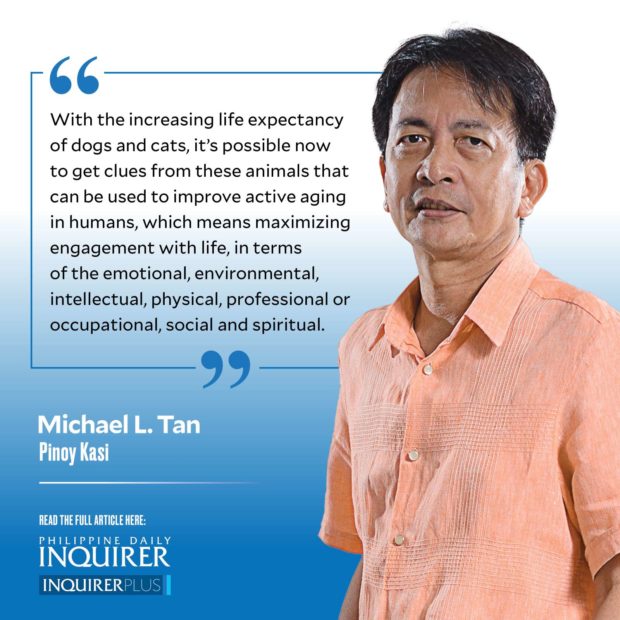Active aging: humans and dogs
If human life expectancy has been increasing all over the world, so, too, has that of pets, especially dogs. When I was in vet school in the 1970s, a 12-year-old dog was considered very old, especially if you used the “1 dog year = 7 dog years” formula. Today, it’s not unusual to meet humans with dogs aged 15 or older.
Like humans, age does take its toll on a dog’s vital senses, and you find chronic diseases similar to that of humans, affecting different systems of the body. One thing is clear though, even with age and afflictions, a dog’s loyalty and love for its humans transcend age. Many of us have our stories of the old dog struggling with a terminal illness and who seem to wait for a beloved human to come home—from school, from work, even from travel— before giving up the spirit.
It’s not surprising then that funds are now being poured into more research on veterinary geriatrics, which does not just look at diseases of old companion animals but at the bigger “anthrozoological” picture, the term referring to the relationships between humans and nonhuman animals.
Because we share so much of our lives with companion animals, especially dogs, research can look for common factors that create illness, as well as wellness, for us and our four-footed friends. With the increasing life expectancy of dogs and cats, it’s possible now to get clues from these animals that can be used to improve active aging in humans, which means maximizing engagement with life, in terms of the emotional, environmental, intellectual, physical, professional or occupational, social and spiritual.
(I did pause with spiritual but then why not; our interactions with dogs and cats might have a spiritual element too for many people, even if the dogs might not have a sense of the spiritual.)
Perhaps the most ambitious research project looking into wellness and active aging is a US-based project called the Dog Aging Project, where people can apply to have their dogs included and, if accepted, send in reports on many aspects of their dogs’ lives: diet, illness episodes, physical activity, physical environment, and many more variables. The researchers then look for correlations, for example between life span and diet. For example, an early report suggests that feeding only once a day is better than multiple feeding.
The project recently published a study on canine cognitive dysfunction or “doggy dementia.” Not surprisingly, lack of exercise seems to be the most important risk factor for this doggy dementia.
As with many research studies looking into variables or factors, scientists do not claim to have established a cause-and-effect relationship; instead, they look into correlations, which can be complicated.
For example, with canine cognitive dysfunction, age brings a deterioration in the senses like sight. With impaired sight, the dog tends to be less willing to move around, which means less exercise, but dementia can come as well from the impaired eyesight causing a decrease in mental stimulation … and the dog’s dementia.
The report also found larger dogs tended to get more exercise than smaller dogs and rural dogs more than urban dogs. The dogs’ humans also had an effect—surprisingly, dogs with older humans tended to get more exercise than those with young humans. It does make sense if you think about it because older humans have more flexible schedules and free time for their dogs.
Think of how that translates into human health.
Lolos and lolas who walk their dogs stand to gain too from all the exercise. But it means, too, you need a certain level of fitness with the senior citizen, to keep up with the dog. The dog, in turn, should be trained not to go too fast, even to just walk alongside their humans.
Aging together with a companion animal just might be a key to a better quality of life in the senior years of both humans and the four-footed best friend.
You can download the scientific report for free—search for “Age and Physical Activity Levels in Companion Dogs: Results from the Dog Aging Project” and “Journal of Gerontology” (yes, a human medical journal). I did find that just reading the report stimulated my brain. That’s a good mental exercise that might help keep dementia away.
mtan@inquirer.com.ph





















